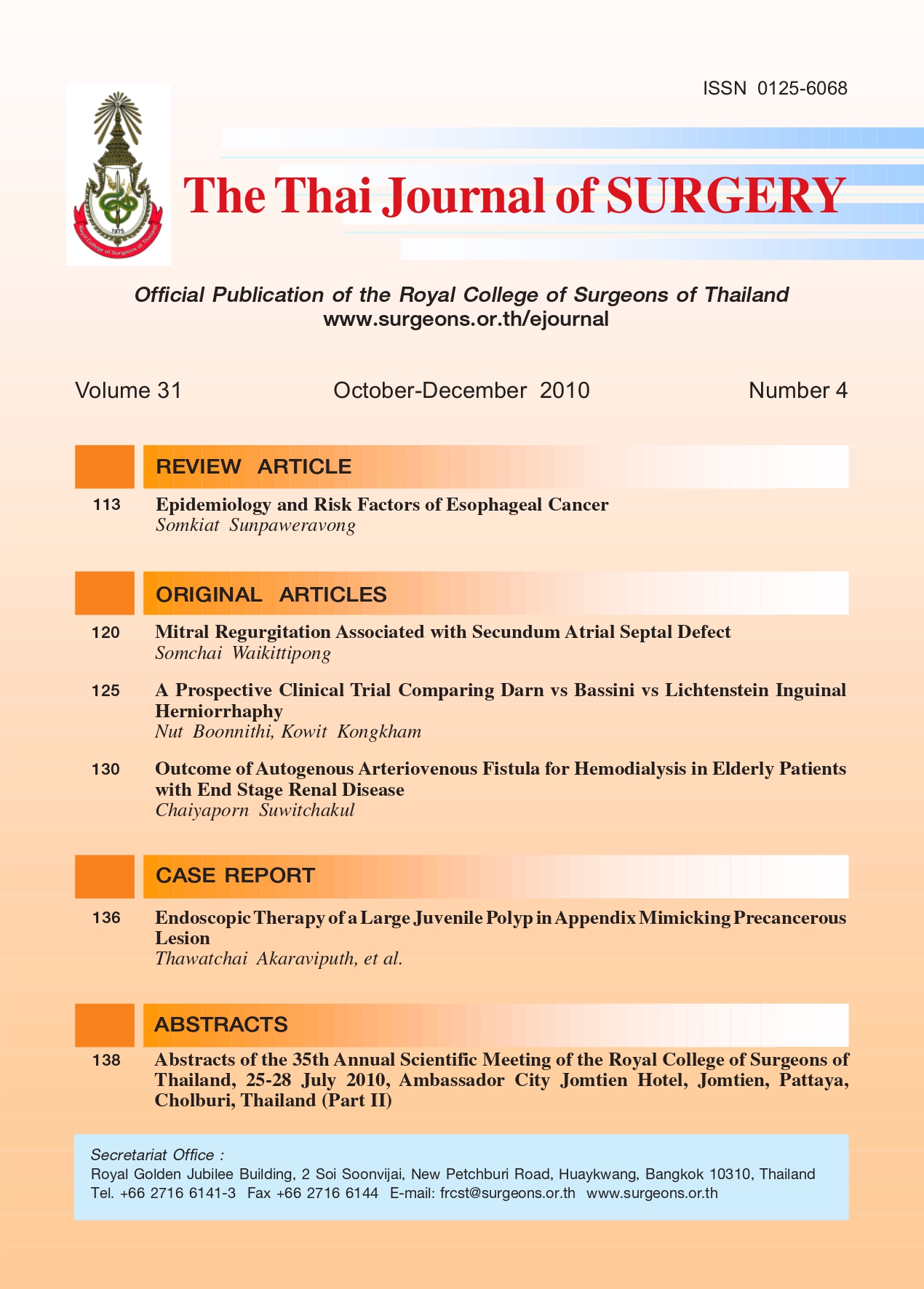Outcome of Autogenous Arteriovenous Fistula for Hemodialysis in Elderly Patients with End Stage Renal Disease
Keywords:
arteriovenous fistula, diabetes, end stage renal disease, hemodialysisAbstract
Objective: To study functional outcomes, in terms of 1-, 3-, 5-year patency rate and post-operativecomplications in patients with end-stage renal disease (ESRD) who underwent autogenous arteriovenous fistulas
for hemodialysis and to compare the outcomes in patients aged over 60 years and those of patients age under
60 years.
Materials and Methods: All records of the patients who underwent autogenous arteriovenous fistula
between January 2003 and June 2007 were reviewed. The patency rates and complications were analyzed in both
groups. The statistic analysis included chi-square test, independent samples t-test, Fisher’s exact test, Kaplan-
Meier survival analysis with log rank test comparison and Cox regression analysis.
Results: From 343 patients, 217 patients met the inclusion criteria. All were divided into two groups
according to the age group. Group 1 (age over 60 years) consisted of 112 patients and Group 2 (age under 60
years) consisted of 105 patients. There were no differences in terms of gender, co-morbid diseases, type of
arteriovenous fistula and biochemical data before operation but only differences in duration of ESRD before operation
(p = 0.028). The patency rates at 1, 3 and 5 years were 76.8%, 54.5% and 48.2% for patients aged over 60 and 81%,
65.2% and 53.3% for patients aged under 60, respectively. There were no significant differences in patency rate for
AVF between both groups (p-value = 0.387). In age over 60 years group, gender and type of fistula were not significant
differences in patency but diabetes was significant differences in patency (p = 0.001). There were no significant
differences in complication between both groups. Multivariate analysis demonstrated significant correlation between
the patency loss and these variables: diabetes (HR = 2.837; 95%CI = 1.912-4.208, p <0.001), active bleeding or
hematoma at surgical site (HR = 4.281; 95%CI = 1.328-13.795, p = 0.015) and surgical site infection (HR = 8.642; 95%
CI = 3.079-24.255, p <0.001).
Conclusion: Autogenous arteriovenous fistula is the first angioaccess for hemodialysis also in older
patients. Survival of the autogenous arteriovenous fistula is independent of age. There is no difference in
autogenous arteriovenous fistula complications across age groups. Diabetes were related to patency loss in older
patients.
References
Nephrol 1996;7:637-46.
2. Létoumeau I, Ouimet D, Dumont M, Pichette V, Leblanc M.
Renal replacement in end-stage renal disease patients
over 75 years old. Am J Nephrol 2003;23:71-7.
3. NKF-K/DOQI Clinical Practice Guidelines for vascular access:
update 2006. Am J Kidney Dis 2006;48(Suppl 1):S176-247.
4. Choi HM, Lal BK, Cerveira JJ, et al. Durability and cumulative
functional patency of transposed and nontransposed
arteriovenous fistulas. J Vasc Surg 2003;38:1206-11.
5. Montreuil B, Leblanc M. Vascular and peritoneal access. In:
Souba WW, Fink MP, Jurkovich GJ, Kaiser LR, Pearce WH,
Pemberton JH, Soper NJ, editors. ACS Surgery: principles
and practice. 6th ed. New York: Web MD Professional
Publishing; 2007. p. 1-26.
6. Singh N, Starnes BW, Andersen CA. Successful angioaccess.
Surg Clin N Am 2007;87:1213-28.
7. Ohira S, Kon T, Imura T. Evaluation of primary failure in native
AV-fistulae (early fistula failure). Hemodial Int 2006;10:173-9.
8. Cante P, Bottet P, Ryckelynck JP, et al. Distal vascular
access for chronic hemodialysis in patients over 65 years of
age. Surgical results. Prog Urol 1998;8:83-8.
9. Ridao-Cano N, Polo JR, Polo J, et al. Vascular Access for
Dialysis in the elderly. Blood Purif 2002;20:563-8.
10. Grapsa EJ, Paraskevopoulos AP, Moutafis SP, et al.
Complications of vascular access in hemodialysis (HD) -
aged vs adult patients. Geriatr Nephrol Urol 1998;8:21-4.
11. Marchi SD, Falleti E, Glacomello R, et al. Risk factors for
vascular disease and arteriovenous fistula dysfunction in
hemodialysis patients. J Am Soc Nephrol 1996;7:1169-77.
12. Lok CE, Oliver MJ, Su J, Bhola C, Hannigan N, Jassal SV.
Arteriovenous fistula outcomes in the era of the elderly
dialysis population. Kidney Int 2005;67:2462-9.
13. Ló pez- Menchero R, del Pozo C, Andreo L, et al. Vascular
access outcomes in patients older than 75 years. Neprología
2006; 26:711-8.
14. Huijbregts HJT, Bots ML, Wittens CHA, Schrama YC, Moll FL,
Blankestijn PJ. Hemodialysis arteriovenous fistula patency
revisited: results of a prospective, multicenter initiative. Clin
J Am Soc Nephrol 2008;3:714-9.
15. Berardinelli L, Vegeto A. Lessons from 494 permanent
accesses in 348 haemodialysis patients older than 65 years
of age: 29 years of experience. Nephrol Dial Transplant
1998;13:73-7.
16. Weale AR, Benis P, Neary WD, et al. Radiocephalic and
brachiocephalic arteriovenous fistula outcomes in the
elderly. J Vasc Surg 2008;47:144-50.
Downloads
Published
How to Cite
Issue
Section
License
Articles must be contributed solely to The Thai Journal of Surgery and when published become the property of the Royal College of Surgeons of Thailand. The Royal College of Surgeons of Thailand reserves copyright on all published materials and such materials may not be reproduced in any form without the written permission.



